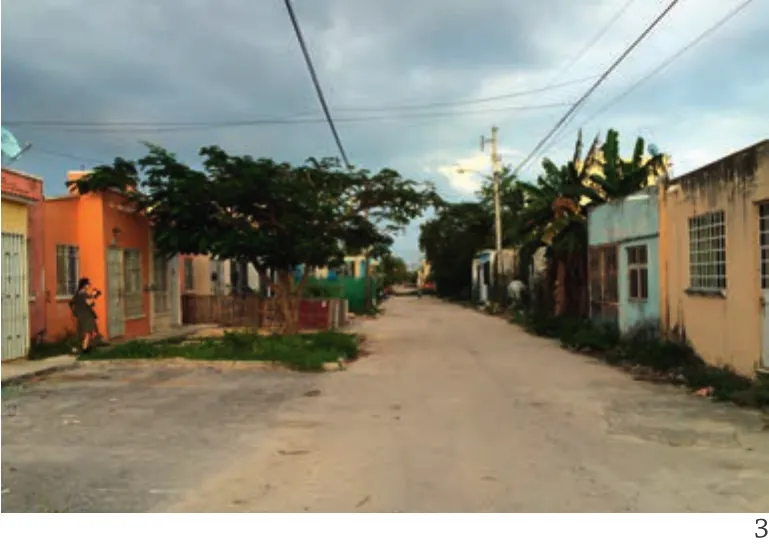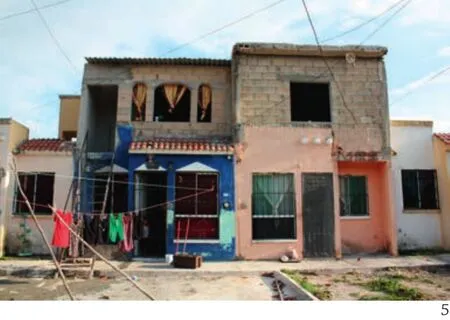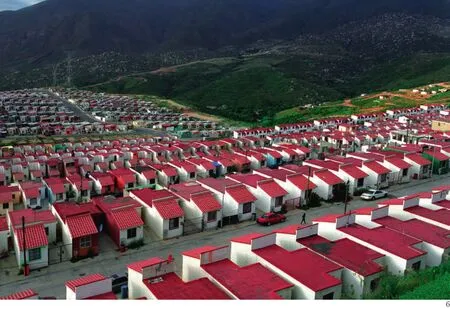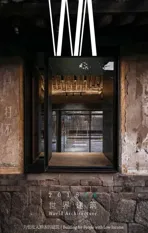通过社会住房战略投资建设更美好城市
2018-09-07戴安娜戴维斯DianeDavis
戴安娜·E·戴维斯/Diane E. Davis
徐知兰 译/Translated by XU Zhilan
在持续若干年的研究和为期几个月的现场调研过程中,哈佛设计研究生院的研究团队针对推动墨西哥社会住房密集化的主要壁垒和影响因素展开了一项研究1)。最终形成了一份涉猎广泛的研究报告,我们在其中辨认出了一系列在土地利用、决策制定和住房建设等方面的挑战因素,在政府提供抵押贷款的情况下,由于社会住房建设能被引导为促进建设更可持续发展城市的推动力,这些困难是可以克服的2)。我们提出的结论原动力是对城市价值的创造过程和更合理的城市化进程的强调,而不在于密集化过程本身。在这一思想的指导下,我们设计了一个新的制度平台将会帮助墨西哥劳动者全国住房基金委员会达成这些目标。其名称为“城市价值创造平台”,致力于为特定背景的社会住房项目申请和获得资助,这些项目不应把庇护空间理解为大规模的生产建设,而应把它们理解为促进更健康的邻里社区聚集和帮助建设更高效运营城市的条件。我们将在下文总结推动这项研究的动因,并突出说明研究获得的重大发现。
墨西哥劳动者全国住房基金委员会诸多挑战的历史渊源
和许多其他拉美国家一样,墨西哥目前正面临许多与城市快速增长相关的问题和挑战,在那些经由大规模住宅建设不断拓展城市边界的区域,问题尤为突出。住房主导的城市蔓延不仅产生了对城市公共服务设施的投资需求,这些投资使当地和国家的预算变得非常紧张,它也加剧了碳排放的增长量并危害了环境的可持续性。在墨西哥的一些区域,城市蔓延还与日益增长的废弃住宅有关,并应部分归咎于住宅建设选址离家庭成员、工作地点和能买到生活必需品的区域都比较远。所有这些因素都引导我们必须协同促进城市密集化发展。墨西哥之所以会面临这些问题,其原因之一是许多住宅开发者在建设过程中预先假设就业岗位数量会持续增长、建筑业会复苏、银行业将重振实力、家庭对基本居住空间的需求也会得到满足等条件,并且整个国家的整体经济发展潜力也会由此通过大规模住宅建设得到增强。
During several years of study and multiple months of fieldwork, a team from Harvard's Graduate School of Design conducted research on the major barriers and enablers to densification of social housing in Mexico.1)The final product was an extended research report in which we identified a series of land use, decision-making, and housing production challenges that should be overcome if government provided mortgage credits for social housing could be marshalled to build more sustainable cities2). Our conclusions were informed by a desire to emphasise urban value creation and better urbanism rather than densification per se.With this in mind, we proposed a new institutional platform that will help INFONAVIT (National Workers Housing Authority) achieve these goals.Called the Urban Value Creation Platform, its aim was to solicit and enable support for context-specific social housing projects that envision shelter not as an object conceived through a mass production mentality, but rather, as a stimulus for assembling healthier neighborhoods and constructing more efficiently organised cities. In what follows, we summarise the motivations for the research and highlight our main findings.
Historical roots of INFONAVIT'S challenges
Like many Latin American countries, Mexico now faces a wide array of problems and challenges that are associated with the rapid growth of cities, particularly in those urban areas where city boundaries are being extended through the mass production of housing.Housing-led sprawl has not only produced growing demands for public investment in urban services that are straining local and national budgets, it also contributes to accelerating carbon emissions and undermined environmental sustainability. In some parts of Mexico,sprawl is also associated with an increase in abandoned housing, which itself owes partly to the tendency to locate housing in areas overly distant from family,jobs, and the basic goods of life. All this has led to more concerted efforts to foster densification. One reason Mexico faces these problems is because many housing its promoters have been working under the assumption that jobs are created, the construction industry is reinvigorated, banks are strengthened, families get their basic shelter needs met, and thus the country's overall economic development potential is strengthened by mass production of housing.
This may be true, but any assessment of gains or losses associated with the mass production of housing should not confined only to the economics of the housing sector. They also relate directly to transportation challenges and socio-spatial exclusion that are reinforced by sprawl. There has been little inter-institutional coordination among the different bureaucracies or government agencies to insure that new housing developments are placed in areas where services and infrastructure are already available,particularly when it comes to transportation services and schools, which unlike water, electricity, and roads remain beyond the purview of housing developers who elect to build in virgin areas of the city. Yet without transport access, citizens often find the daily costs of commuting outweigh the gains of home ownership,at times leading to housing abandonment in its worst-case scenario. Even for those who keep their new homes despite the long-distances, the quality of social life is poor because the developments remain largely abandoned during the daytime, some with the appearance of ghost-towns. Under such conditions,disorder and urban violence is a common occurrence,thus explaining why the social problems associated with mass production of housing have been greatest in the most socially and economically marginal urban settlements, where exposure to environmental ills and chronic poverty have also combined with informality and neglect to produce housing developments where lawlessness reigns. It may be worth noting that where a density of social life exists – as has been seen recently in the redevelopment of downtown areas of Mexico City, after the revitalisation and repurposing of formerly abandoned warehouses and other properties– there tends to be much less violence and crime.
These and other social problems that characterise the periphery of rapidly growing cities stand in contrast to the wide array of obvious gains seen in other sectors of the Mexican economy in recent years. The transition to neoliberalism and free-market economies generated new opportunities for cities and private investors to keep their economies growing through the development of finance, services, and real estate, even in the face of declining industrial firm competitiveness. But unfortunately, most of these city-builders have failed to pay attention to the social and spatial problems associated with sprawl; they have ignored the growing risks associated with environmental vulnerability and violence; and they have failed to make headway in transforming urban infrastructure so as to make the city work more efficiently and sustainably.
The bottom line is that there are multiple negative externalities associated with dramatic transformations in land use generated by the mass production of housing in the urban periphery.From inadequate infrastructure to environmental degradation to unchecked sprawl, rapidly urbanising cities often host a plethora of problems that persist despite – and sometimes because of – the growing income share accruing to middle classes and their newfound urban housing demands, as well as the nation's transition from a purely industrial economy to a financial and commercial economy. Whatever the origins, we must acknowledge that rapid and sprawling urbanisation is creating insurmountable problems. If we fail to build cities that distribute the gains associated with a renewed focus on the relationship between urban economic growth and urban redevelopment that the current moment clearly offers, future generations will suffer.
The challenge, in short, is to use housing to produce patterns of urbanisation that can prevent or mediate current risks – whether related to environment,violence, persistent poverty, or other vulnerabilities. The failure to do so will put Latin American cities on the path towards unsustainability, energy-related and otherwise.
One way to do so is to more actively involve urban planners in decisions about the production and location of housing, particularly if their aim is to help all levels of government formulate mid and long-term objectives to guide urban growth more efficiently and in a sustainable manner. A focus on producing housing that takes into account existent infrastructure and services investments (e.g. phasing, where and when investments will take place) could begin to help alleviate the severe financial strain on municipalities caused by rapid and disorderly urbanisation. In the absence of such measures, we will see continue to see urbanisation patterns that consume significant amounts of land per capita, and which will generate larger infrastructure installation and maintenance costs to extend water, sewage, and electricity networks over long distances in order to reach peripheral and less dense developments. To provide such necessities as waste collection and policing in new areas will required greater public sector expenditures, many of which are beyond the reach local authorities entrusted with such obligations.

2墨西哥梅里达地区低密度、 大规模建设的住房,由于位置不佳或其他问题,呈现半废弃的破旧状态/Low density,mass produced housing that is also dilapidated and semiabandoned, owing to bad location and other issues, Mérida,Mexico(摄影/Photos: Research Team of Harvard GSD)

3墨西哥梅里达地区低密度、 大规模建设的住房,由于位置不佳或其他问题,呈现半废弃的破旧状态/Low density,mass produced housing that is also dilapidated and semiabandoned, owing to bad location and other issues, Mérida,Mexico(摄影/Photos: Research Team of Harvard GSD)

4墨西哥梅里达地区低密度、 大规模建设的住房,由于位置不佳或其他问题,呈现半废弃的破旧状态/Low density,mass produced housing that is also dilapidated and semiabandoned, owing to bad location and other issues, Mérida,Mexico(摄影/Photos: Research Team of Harvard GSD)
事实也许如此,但任何对大规模住宅建设相关利弊得失的评估都不应局限于住宅建设领域的经济因素。它们与城市交通面临的挑战和社会空间排斥的现象更有直接的关联,城市蔓延加剧了这些问题。目前为止,在不同官僚机构或政府办事处之间几乎还不存在任何体制内的协调工作来确保新的住宅开发项目选址一定落在已有公共服务设施和基础设施的区域,尤其是交通设施和教育设施——它们不像水、电管网和道路系统——对选择城市处女地作为项目基地的住宅开发者来说,这些因素尚不在考虑范围内。然而如果住地交通不便,市民就会发现日常支出的通勤成本超出了获得住宅所有权带来的好处,在最差的情况下,有时甚至会导致住房遭到废弃。而对那些克服了远距离通勤的困难,留在新家的人们来说,社会生活的品质也很低劣,因为新开发的社区在白天大部分时间都无人居住,有些甚至看起来像鬼城。在这些区域,失序和城市暴力都时有发生;由此也解释了为什么在经济和社会层面都最为边缘化的城市聚居区,会出现最为严重的大规模住宅建设相关社会问题;这些区域还面临最严重的环境恶化和长期贫困问题,加上住宅建设开发中的非正规程序和开发者漫不经心的态度,一起共同导致了这些区域里违法行为猖獗不断的现象。也许值得我们注意的是,在社会生活密集度达到一定程度的区域——正如最近在墨西哥城市中心开展的再开发项目中,对昔日的废弃仓库和其他建筑进行复兴和重新设计——暴力和犯罪的行为也更少出现。
这些问题和其他的社会问题已经成为快速增长城市的外围区域的主要特点,与墨西哥经济最近几年在其他领域所取得的成就形成了鲜明对比。向新自由主义和自由市场经济转型的过程为城市和私人投资者提供了新的机会,让他们能通过金融业、服务业和房地产的发展保持经济增长,甚至在面临工业企业竞争力下降的情况下也不受影响。然而不幸的是,这些城市建设者中的大部分人都未能足够重视与城市蔓延相关的社会问题和空间问题;他们忽视了和环境脆弱性和暴力行为有关的增长风险;他们也未能在通过改变城市的基础设施来提高城市运作效率和可持续性发展方面取得进步。
最重要的问题是在城市周边进行的大规模住宅建设导致了土地利用方式的剧烈转变,从而产生了若干负面的外部性。从匮乏的基础设施到环境恶化、再到盲目的城市蔓延,快速推进城市化进程的城市区域通常都面临太多不断持续的问题——尽管中产阶级的收入得到了增长,他们对新建住宅的需求也在增长;而国家在从单一的工业经济转向金融和商业经济的过程中,有时也产生了一些问题。无论是什么原因,我们必须承认快速蔓延的城市化进程正在产生许多难以解决的问题。如果我们不能以全新的态度重视城市经济增长和目前正开展的城市再开发之间的关系,建设合理分配利益的城市,那么我们的后代将痛苦不堪。
其挑战简而言之就是如何利用住宅建设所形成的城市化进程模式,来预防或调和目前所面对的各类风险——无论是和环境、暴力行为、持续贫困还是其他的脆弱因素相关。如果不能做到这一点,那么拉美地区的城市就将走向在能源消耗和其他方面不可持续的方式。
方法之一是更主动地邀请城市规划师参与住宅建设和选址的决策,如果他们的目标是致力于帮助所有层级的政府形成中期和远期目标、引导城市增长以更高效和可持续的方式发展,就更应如此。住宅建设中对现有基础设施和服务设施投资的重视(如采用分期规划,确定投资的地点和时间)能帮助减轻快速无序的城市化进程对地方政府造成的严重财政压力。如果不采取这些措施,我们就会继续看到城市化进程模式消耗大量的人均土地拥有量,并会为接通周边密集度更低的开发项目地段的基础设施,长距离地延伸给排水和电力官网,由此产生更大规模的基础设施建设和运营费用。在新建区域提供垃圾收集和警务这样必要的公共服务则需要更多的公共部门支出,其中许多项目已经超出了地方政府力所能及的范围。
为未来行动提供新的思想范式
这种更加面向未来、主动协调城市与区域关系的社会住房建设方式应该是什么样的?如上所述,在监督和制定住房建设法规的各个层面吸纳城市规划师的参与——不仅是在地方政府层面——会更可能把住房建设投资和现有的基础设施挂钩,帮助形成更高效和可持续发展的城市化进程。经过规划的集约化高密度住宅能加强有效的空间规划,从而减少对基础设施的初始投资和运营维护成本。这些行动都会为明智的住房建设投资奠定长远的经济基础,可以确定,这些投资除了创造居住价值,还能创造城市价值。如果住房建设投资相关的经济、社会和生活方式方面所获的利益,能归于更大范围的邻里住区、甚至整个城市,而不仅有利于个体的住宅购买者或销售商,就产生了城市价值。这样的价值创造要求训练有素的专业人士有意愿、并且有能力除了评估住宅建设的抵押贷款成本之外,对背景环境和位置也进行评估;除此之外,还要求他们拥有全新的思维方式——不仅是有关土地利用规划和住宅与基础设施之间关系的全新思想,还包括有关住房本身意义和作用的理念——公共机构和私人企业里的住房领域专业人士尤其如此。
有关第一个问题,由专业人士对住房产业的监督和管理必须采取必要的措施,逆转下达投资的决策过程。相比起先为更多住房建设开启绿灯,然后奋力确保交通和社会基础设施条件能提供充足生活条件的方式,所有层级的政府机构都必须优先推动能把住宅生产和供应结合在一起,由此创造出社会关系活跃和交通便捷的社区环境的基础设施投资项目。当然,知易行难。这种“开倒车”的时序逻辑在像墨西哥这样的拉丁美洲国家已有悠久的历史,它应归咎于非正规程序的聚居区增长过程,这个过程加强了市场的供给经济学逻辑,权威部门也在其中努力修复由既成事实的自建住房增长造成的基础设施鸿沟。但令人震惊的是,同样的逻辑竟然也主导了正规的住房建设过程。其部分应归咎于城市区域中碎片化的政府管理组织逻辑。联邦政府、州政府和地方政府在体制上都过于彼此疏远,在住宅的生产建设、监督和金融投资方面关系尤为割裂。政府部门内谜一般地充斥着各种彼此竞争和职能重叠的机构,都受命关注住房问题或城市基础设施问题,却鲜有同时关注这两方面的机构,甚至几乎没有同时跨越这3层政府级别的部门。如果基础设施的开发需为住房建设提供导向而非被动相应需求,而我们也需要建设更可持续发展的城市,那么就必须首先改变这些零散的关系。
A new thought paradigm for future action
What might this more future-oriented,proactively coordinated urban and territorial approach to social housing look like? As just noted,involving urban planners in the monitoring and regulation of housing production at all levels –not merely at the municipality – will make it more likely that investments in housing are connected to existent infrastructure in ways that help create more efficient and sustainable urbanism. Planned,compact, and dense housing will reinforce efficient spatial arrangements that, in turn, can reduce initial capital investments in infrastructure as well as operating and maintenance costs. Such actions will go a long way in laying the economic groundwork for wise housing investments, which can be defined as investments that create urban value, not merely housing value. Urban value is generated when the economic, social, and lifestyle gains associated with investment in housing accrue to the larger neighbourhood and even city as a whole, and not merely to the individual buyer or seller of the house.Producing such value not only requires trained professionals with the willingness and capacity to assess the context and location of housing construction, not merely its mortgage costs. It also requires an entirely new way of thinking: not just about land use planning and the relationship between housing and infrastructure, but also about the meaning and role of housing itself, particularly among housing professionals in both public and private sectors.
With respect to the first issue, professionals overseeing and managing the housing industry must be willing to undertake the necessary steps to reverse the ordering of investment decision-making.Rather than giving the green light to more housing and then struggling to insure that transportation and social infrastructure to create livability follows,government agencies at all levels must prioritise infrastructural investments in ways that connect housing production and supply to create socially vibrant and well-connected environments. Of course, this is easier said than done. This "backwards"temporal logic has a long history in countries like Mexico the rest of Latin America, owing to the growth of informal settlements that reinforced a supply-side logic in which the authorities attempted to remediate the infrastructure gaps generated by the proliferation of self-built housing, but after-thefact. Surprisingly, however, the same logic prevails even when it comes to formal housing. Some of this owes to the fragmented organisational logic of governance in the urban sector. Federal, state,and local agencies are far too often institutionally divorced from each other, particularly with respect to the production, monitoring, and financing of housing. The sector is riddled with competing and overlapping agencies with mandates to focus on either housing or urban infrastructure, but rarely on both domains simultaneously and even more rarely across all three levels of governance. Changing these fragmented relationships must be a priority if infrastructural development is going to guide rather than respond to housing production, and cities are going to be built more sustainably.
Yet because institutional reforms of this magnitude are long-term goals that will be politically controversial and can take decades, advocates for more sustainable housing must also be able to look elsewhere for new thinking that can make a difference in the shorterterm. In that sense, those who care about cities and national economic prosperity must work together to make progress on the second objective noted above,which is to change the way citizens, bankers, urban planners, developers, and construction industry professionals think about housing. Most have been trained to consider housing as an object – shelter that protects against the elements; a dwelling typology that minimises construction costs and maximises user friendliness; or a built form whose materiality embodies a confluence of resource availabilities, design ingenuity,consumer desires, and market dynamics. Yet some of the most inspired housing experiments both past and present have been produced by those who conceptualise the house as a subject: conceived as a material construct capable of generating new social arrangements,producing alternative spatial geographies, and transforming city landscapes in ways that fashion a more vibrant urbanism and thus the creation of new possibilities for urban value creation.
One way to recognise the subjective dimensions of housing is to conceptualise the built form of a house in terms of its agency, or better said, to see housing in light of its social and economic value activation potential. For good or bad, any given housing typology will structure the daily lives of its inhabitants, a neighbourhood, and even an entire city – while also establishing the socio-spatial context in which residents are either isolated or integrated with other city dwellers. By assembling new social configurations through various building forms and their particular location, houses do much more than offer shelter. They also affect the social relations that occur in everyday exchanges within a household, a neighbourhood, or a city. By thinking beyond the house as mere object, and by identifying its relationship to and impacts on the exterior worlds around it, urban planners, real estate developers, and home builders will find new ways to innovate housing form and function, and not merely vice-versa. Acknowledging that the boundaries separating activities within and outside the house are permeable and at times artificially constructed will go a long way towards liberating a wide array of professionals from any proclivity to treat housing as just an object that provides a shelter and serves as a real estate asset.
Armed with the realisation that housing serves as a foundational structuring element in the production of better urbanism and a more vibrant and equitable socio-economic environment, the task at hand is focus more explicitly on housing's activation potential, and to ask what new types of socio-spatial, economic, or even political relationships and contributions to everyday urbanism that a given housing investment will produce, at what scale, and with what impacts on the future of cities. INFONAVIT can and should play a more active role in fostering this new type of thinking about housing – and a subject and not merely an object. And our research team has suggested that one way to change the way developers and governing authorities or mediating agencies,including INFONAVIT, will think about housing is to design new institutional arrangements to better link planners to housing producers at a scale smaller than the nation but larger than the municipality. We propose to call this new institution: the Urban Value Creation Platform, or UVCP. Rather than focusing just on densification, which may or may not be the most appropriate way to offer social housing, the UVCP would commit itself to the creation of what we call "urbanistically defensible" housing – defined as housing that contribute to a more networked,vibrant, sustainable, and economically dynamic urban environment.

5墨西哥梅里达地区低密度、 大规模建设的住房,由于位置不佳或其他问题,呈现半废弃的破旧状态/Low density,mass produced housing that is also dilapidated and semiabandoned, owing to bad location and other issues, Mérida,Mexico(摄影/Photos: ResearchTeam of Harvard GSD)
然而,因为这个量级的机构改革属于长期目标,必将引起政治争议并需几十年时间才能完成,倡导更可持续发展的住房建设机制就必须在其他方面寻求能短期见效的新思路。因此,关心城市和国家经济经济繁荣的人就必须共同努力在上述的第二个目标方面取得进展,也就是改变市民、银行家、城市规划师、开发商和施工建设领域的专业人员对住房的认识。他们中的大部分人所受的训练都只把住房当做客观对象来看待——即能保护人类免遭外界侵害的庇护空间;能以最小化建设成本让使用者得到最大程度方便的居住类型;或一种建成造型,其物质形态能对资源的可获得程度、社会创造力、消费者欲望和市场动力产生影响等等。然而在过去和现在最受启发的住房实验中,就有一部分是由把住宅视为主体的人们建成的—,他们把住宅理解为能产生新的社会关系、形成其他空间地理、并对城市景观进行转化的物质建设过程,其转化城市景观的方式能激发更具活力的城市化过程,并由此为创造城市价值提供新的可能性。
认识住宅主体维度的一种方式是通过其媒介来理解住房的建成形式,更准确的表达是,从激活住房的社会和经济价值潜质的角度来理解它。无论品质优劣,任何一种住房类型都能为其居住者、邻里社区,甚至整个城市提供日常生活的结构——与此同时也建立起社会空间背景,生活在其中的居民与其他城市居民的关系要么是孤立隔绝的,要么是联为整体的。住宅通过不同的建筑形式及其特殊的地理位置构成新的社会分配模式,其作用远大于提供庇护空间的功能。它们也会影响一个家庭、一组邻里或一座城市内部日常交流的社会关系。通过打破把住宅仅仅视为客体的思维禁锢,并确认它和周围外部世界的关系、及其对这些关系的影响力,房地产开发商和住宅建设者会找到革新住房形式和功能新方法,而不仅是被动的反向方式。从认识到分隔住房内外部活动的边界是可穿透的、并常由人为建立的,到把许多专业人士从仅仅把住宅视为提供庇护和作为不动产的客体思想中解放出来,还有很长的路要走。
在领悟到在促成更合理城市化进程和更具活力和公正公平的社会经济环境的过程中,住宅是决定性的基本因素的前提下,当前的任务就是要更明确地关注如何激活住房潜质,并思考特定住房投资项目能产生什么样的新类型社会空间、经济或甚至政治关系,它能对日常城市化进程做出什么贡献,以及它们应该在什么级别对未来城市产生怎样的影响等问题。墨西哥劳动者全国住房基金委员会能够也应该在推动这些住宅认识的新理念方面扮演更积极的角色——把住房当作主体,而不仅是客体。我们的研究团队也提出建议,认为改变包括墨西哥劳动者全国住房基金委员会等在内的开发商、政府权威部门或协调机构未来认识住房的方法之一是设计新的制度方式,在介于国家和地方政府之间的尺度上把规划师和住房建设者联系在一起。我们提出这一新的度叫做“城市价值创造平台”,或简称为UVCP。相比起仅仅着眼于住房密集化过程——它不一定是提供社会住房的最佳方式,“城市价值创造平台”将投身于创造我们所谓具有“城市空间可防御性”的住房——即有助于形成更网络化的、更活跃、更可持续和更具经济动力的城市环境。
“城市价值创造平台”如何发挥作用
城市价值创造平台将围绕墨西哥劳动者全国住房基金委员会的建立初衷、作为服务于墨西哥工人、雇员和整个国家的金融机构来运作,但其履行使命的方式则更多地与面对最近与快速城市化发展和城市蔓延相关挑战的任务一致,即通过推动采用更全面的指标数据,保证城市价值创造的影响成为抵押贷款项目的核心考量因素。究其本质,城市价值创造平台将会挑战以不变应万变处理之前所有开发项目的方式,并其工作开展的前提是认为通过与当地利益相关者进行目的更为明确的沟通,由墨西哥劳动者全国住房基金委员会的国家代表发挥关键作用进行协调、召集多方对谈,能让资金的花费更具生产效率。通过这个平台的协调作用,它能增加社会住房获得抵押贷款支持的可能性,并为个人住房拥有者和更大范围的城市环境创造财富。如果这个平台能像设想的方式运作,就能以同时向墨西哥劳动者全国住房基金委员会回馈中期利益的方式平衡这些投资杠杆,同时保证实现金融偿付能力,让未来也有更多项目能获得这些资金。
这个制度再设计方案来源于哈佛大学领导的研究团队对案例进行现场调研分析的理性成果。我们在最初力求认定阻碍和促进住宅密集化过程的各种因素时,有证据表明不同城市的运作机制也各不相同,同一资金补助项目无法在所有城市取得相同的效果,其原因在于许多特定背景的条件不同,其中包括先前的住房投资、对密集化定义的见解分歧、以及地方权威部门与墨西哥劳动者全国住房基金委员会共享相同的密集化优先项目的程度也各不相同。这促使我们考虑如何超越联邦政府授权金融激励方式的单一设定条件,它无法顾及不同地方和地区住房市场的条件,也无法认识到修改建筑风格和住房类型以适应地方气候、文化、社会或就业条件的重要性。这份报告中记录的研究也揭示出,在这些过程和其他住房供应过程中,关键利益相关者之间的理想协调过程几乎从未实现,其原因不仅归咎于地方政府部门不愿在社会住房投资项目应该如何在更广泛地域背景下进行选址方面加以思考,也在于在地方行动主体和更靠近中央的联邦办事处之间存在制度和市场逻辑方面的断层,而后者通常又为促进密集化过程提供资源和纲领性的指导。
我们的研究进一步显示,通过共享住宅密集化的目标,在政府的不同层面(地方、大城市、各州、国家)把权威机构和各种资源联系在一起的可能性在不同的城市也有所不同,它取决于在大城市区域运作的地方政府数量,以及甚至是否存在管辖大城市区域范围的协调机构等等因素。甚至在那些绝无仅有的少数城市中——即能依靠正式成立的地区协调机构进行运作的城市,他们能以密集化作为目标召集利益相关者共同商议的能力也十分有限,这在很大程度上归咎于财政资源的匮乏和激励不足,并且需要涉及的地方行政区数量过多。因此,在社会住房投资项目和更广泛的区域规划目标之间进行协调方面想要取得进展,其首要因素就在于在关键行动主体之间进行专门的或非正式的协商,在区级行政单元数量较少(无论是绝对数量还是相对数量)的城市较容易实现。
总而言之,这些发现推动了我们的研究团队为激励更结构化的协调程序寻找新的方法,而避免不得不对制度或司法进行改革的做法。我们由此提出,进行协调的主体应该积极参与到规模介于地方级别和联邦政府级别之前的区域范围的决策过程中去,他们还应该能在所有政府层面召集和协调利益相关方开展对话,其方式应能在联邦政府、州政府和地方政府级别的项目之间取得平衡,能处理影响每一个大城市环境的具体推动因素和条件,以增加城市的资产,并创造个人和集体的财富。有鉴于此,我们认为城市价值创造平台能为实现这样的协调目标在体制方面提供独特的契机。墨西哥劳动者全国住房基金委员会早已在各州政府设立了在中等规模尺度兼顾地方政府和联邦政府利益的代理机构;它有各类资源可用于围绕新住房项目激励各方对话和激发创造力的工作,尤其是那些以满足地方城市具体需求为目标的项目;它在更广义的金融利益方面也需要确保其抵押贷款项目能创造城市价值,因为只有通过这些投资,才能增强国家经济的根本基础。
How the Urban Value Creation Platform(UVCP) would work
The Urban Value Creation Platform would build its mission around INFONAVIT's founding principles as a financial institution intended to serve Mexican workers, employers, and the country as a whole, but bring this mission more in line with recent challenges associated with rapid and sprawling urbanisation by promoting the use of a wider range of metrics to ensure that urban value creation impacts become central to its mortgage programmes. In its essence, the UVCP would be able to challenge the one-size fits all mentality of prior programme development, and work under the assumption that through more purposeful engagement with local stakeholders, mediated by INFONAVIT state delegates serving a key role in coordinating and convening conversations,money can be more productively spent. Through its coordinating activities, the Platform could increase the likelihood that mortgage credit support for social housing will create assets for both the individual homeowner and the larger urban environment. If the Platform works as conceived, such investments can be leveraged in ways that also bring medium-term returns back to INFONAVIT, both ensuring financial solvency and making funds available for future projects.
This proposed institutional redesign finds its origins and rationale in the case study fieldwork undertaken by the Harvard-led research team. In first seeking to identify the barriers and enablers to densification, evidence suggested that different cities operated under different dynamics, and that the same subsidy programmes did not produce the same results in all cities, owing to a range of context-specific conditions including prior housing investments, differences in agreement over definitions of densification, and the extent to which local authorities shared the same densification priorities as INFONAVIT. This motivated a concern with moving beyond a single set of federallymandated financial incentives that cannot take into account different local and regional housing markets,or the importance of modifying building styles and housing typologies to accommodate local climactic,cultural, social, or employment conditions. Research documented in this report also revealed that the ideal of coordination among key stakeholders around these and other housing supply matters is rarely met, owing not just to the unwillingness of local governing authorities to think about the larger territorial context in which social housing investments should be located, but also because of an institutional and market logic disconnect between local actors and the more centralised federal agencies that offered the resources and programmatic guidelines to foster densification.
Our research further showed that opportunities for connecting authorities and resources on different levels of governance (local, metropolitan, state, and national) behind densification aims were differentially distributed across various cities, depending on the number of municipalities operating in the metropolitan area and whether metropolitan coordinating agencies even existed, among other factors. Even in those few cities able to rely on formally established territorial coordinating agencies, the capacities to bring stakeholders together behind densification aims were limited, owing in no small part to the absence of fiscal resources and incentives to do so, as well as the number of municipalities involved. Because of this, progress on coordination between social housing investments and larger territorial planning aims owed primality to ad hoc or informal negotiation among key actors, which was easier in cities with a small number of municipalities(both absolutely and relatively).
Overall, these findings motivated our research team to identify new ways of better incentivising a more structured coordination process, without having to turn to constitutional or juridical reform.We have thus proposed that coordinating bodies should be actively operating at an intermediate scale of territorial decision-making, situated somewhere inbetween the local and the federal, and they should be able to convene and coordinate conversations among stakeholders at all governance scales, in ways that allow a leveraging of federal, state, and local programmes that can address specific forces and conditions operating in each metropolitan environment to strengthen urban assets and create individual and collective value. In light of this, we feel that the Urban Value Creation Platform would offer a unique institutional opportunity to make such coordination aims real. INFONAVIT already has state delegates who work at the intermediate scale straddling local and federal concerns; it has the resources to incentivise conversations and inspire creativity around new housing projects specifically geared to fit local urban conditions; and it has a larger financial interest in insuring that its mortgage credit programmes will create urban value, because through such investments the basic fundamentals of the national economy are strengthened.
The proposed UVCP would be structured less as a hierarchical decision-making body and more as a convening assemblage on the urban level informed by a set of principles,which include: access, integration, activation,and collective goods. By insuring that housing production would respond to these priorities in a given metropolitan environment, INFONAVIT would be better able to extend its subsidies in value-creating manner. By mounting a dedicated"platform" capable of convening local actors,INFONAVIT would become a leader in fostering coordination, bringing all actors and sectors together to focus on a given territory, such as those confronting a metropolitan planning institute. We further suggest that the aim of the platform would be to identify and support for tactical projects that broker coordination through targeted incentives and strategic collaboration. This project-based strategy allows more flexibility than focusing on the formation of a strict urban plan(which can take years to write and approve, and may not actually be followed in reality even when it does exist). More importantly, it allows a single or a set of projects to create momentum for value-generative approaches to housing development that serve to benefit a broader constituency and can propel a more innovative and self-sustaining model for production into the future.

6 墨西哥劳动者全国住房基金会住宅项目/The INFONAVIT housing project(摄影/Photo: Livia Corona)
我们设计的城市价值创造平台的组织结构会形成不那么等级森严的决策机构,而更像是一个在城市尺度上遵从一系列原则、具有召集功能的集合体,这些原则包括——交通便利性、整体性、激活作用和集体财产。通过确保在某个大城市环境下的住房生产建设能够响应这些优先事项,墨西哥劳动者全国住房基金委员会最好能把资金补贴的项目拓展为创造价值的方式。通过增设能召集地方行动主体的、精心设计的“平台”,墨西哥劳动者全国住房基金委员会能成在促进协调、召集所有行动主体和所有部门——如那些反对大城市规划的机构——共同关注特定区域方面成为领导者。我们更进一步建议,这个平台的目标是找到那些通过定向激励和战略合作的方式以协调人身份促成多方协调的战略合作项目,并为其提供支持。这种以项目为本的策略具有更大的灵活性,而不是关注编制条款严格的城市规划(这些规划可能经年累月才能完成编制和批准的过程,并很可能根本得不到落实)。更重要的是,这个策略能为单个项目或一系列项目创造出为住房开发创造价值的动力,能让更广大的选区获得利益,并能为推动形成更具创新性和自给自足的未来住房建设模型。
结语
考虑到最近安德烈斯·曼努埃尔·洛佩斯·奥夫拉多尔当选总统,现在正是在墨西哥推广这样一项体制创新的良好时机。作为墨西哥市的前市长,这位政治家一直以来都承诺要在住房方面实施更进步的社会政策,其竞选纲领也表明他对墨西哥日益扩大的不平等现象甚为关心,因此洛佩斯·奥夫拉多尔总统可以能够重塑墨西哥劳动者全国住房基金委员会的使命。任何类似的努力都和墨西哥最近升温的有关联邦制度的讨论和人们越来越关注大城市行政管理失效问题的现象相吻合3)。在过去的6年里,对于哪些城市决策应该下放到地方(行政区级别或是州级)而哪些应该由国家决策也有越来越多的讨论。我们也已见到,最近主要的大城市区域(如墨西哥市)提出了针对城市住房和商业开发应通过土地增值税的方式收税,因而产生了政治矛盾,这项政策的目的是为了建立基础设施建设的基金,实现更可持续的城市化进程。我们提出的城市价值创造平台能让许多这样的优先事项得到探讨并得以实现,而不需要涉入对宪法进行根本修改的政治险境。实际上,这一平台能在所有这些政府层面形成新的对话,而不需要把任何当选的权威机构撇在一边。它也能在加强呼吁下放决策权限的民主诉求的同时,与国家层面保持联系,并从国家层面进行统筹。同样重要的是,由于最近的宏观经济危机也有部分源于大规模过度城市化进程的因素,城市价值创造平台的活动也找到了方法,为投资城市和城市化进程的项目和经济偿付能力与经济繁荣重新联系在一起。通过在城市层面关注对目标区位的战略投资——城市价值创造平台能实现这一目标——墨西哥有可能扭转由过度建设和城市蔓延带来的经济、社会和环境问题。就其本身而言,它对那些质疑谁在联邦社会住房项目和投资中获益、谁又受损的批评给出了积极和具有建设性的反馈,为地方的利益相关者提供了更积极参与此类决策、从而获取更多主动权的可能性。□
Epilogue
In Mexico, now appears to be just the right moment for such an institutional innovation, with the recent election of Andrés Manuel López Obrador.A former mayor of Mexico City, a politician who has long articulated a commitment to progressive social policy in housing, and someone whose campaign showed itself to be deeply concerned with growing inequality in Mexico, President López Obrador could recast the mandate of INFONAVIT. Any such efforts would dovetail with recent heated debates over federalism in Mexico, and the growing concerns over the failures of metropolitan governance.3) Over the past six years, there has been growing discussion of which urban policy decisions should be made locally(either at the municipality or the State) and which ones nationally. We also have seen political conflict over recent efforts by major metropolitan areas (Mexico City for example) to tax or charge urban housing and commercial developers via land value capture mechanisms so as to generate funds for infrastructure investments that can facilitate more sustainable urbanism. The proposed UVC Platform allows many of these priorities to be discussed and achieved without having to enter the treacherous political terrain of seeking fundamental changes in the Constitution. Indeed, the proposed UVC Platform allows for a new conversation across all these levels of governance without sidetracking any single set of elected authorities. It also strengthens the democratic calls for bringing decision making closer to the ground while also keeping connection to and mediated oversight from the national scale.Just as important, because the recent macroeconomic crisis finds some of its roots in massive over-urbanisation, UVC Platform activities also a path forward in re-linking investments in cities and urbanisation to economic solvency and prosperity.By paying attention to strategic investments in targeted locations at the level of the cities –something that will be possible through the UVC Platform activities – Mexico may be able to reverse the economic, social, and environmental problems associate with overbuilding and sprawl. As such, it will provide a positive and productive response to critics who have raised questions over who gains and who loses from federal social housing programmes and investments, offering opportunities for local stakeholders to be involved in such decisions more actively, thus taking more ownership of such decisions.□
注释/Notes
1)这项研究针对墨西哥的7座不同城市展开,如需获得更详尽的项目信息,请联系作者:ddavis@gsd.harvard.edu/For more information on this initiative,which built on the study of 7 different cities in Mexico,please contact the author at: ddavis@gsd.harvard.edu.
2)最终报告能在“墨西哥城市倡议”网站获得/Access to the final report is available online via the Mexican Cities Initiative website: https://research.gsd.harvard.edu/mci/portfolio/building-better-cities/
3)尽管墨西哥联邦政府有特殊基金支持大城市项目,在地方政府、州政府和联邦政府部门之间的政治紧张关系已经妨碍了任何真正有效的大城市政府的存在。在墨西哥,人们可能认为在这些方面取得最长足进步的是瓜达拉哈拉,它也是我们的案例研究对象之一。但即使在这个案例中,也是地方政府(瓜达拉哈拉)市长的个人魅力和社会关系左右着大城市决策的指定,而不是真正的区域平台或运作良好的协调机制。/Although the Mexican federal government has special funds to support Metropolitan projects, the strong political tensions between municipalities, states,and federal governing authorities gets in the way of any truly effective metropolitan governance institutions.In Mexico, one might speculate that the most progress in these regards has been undertaken in Guadalajara,one of our case studies. But even in this instance, it is a personal charisma and relationships of the Mayor of one of the municipalities (Guadalajara) that is usually behind Metropolitan policymaking, not any truly shared territorial platform or well institutionalised coordinating capacity.
